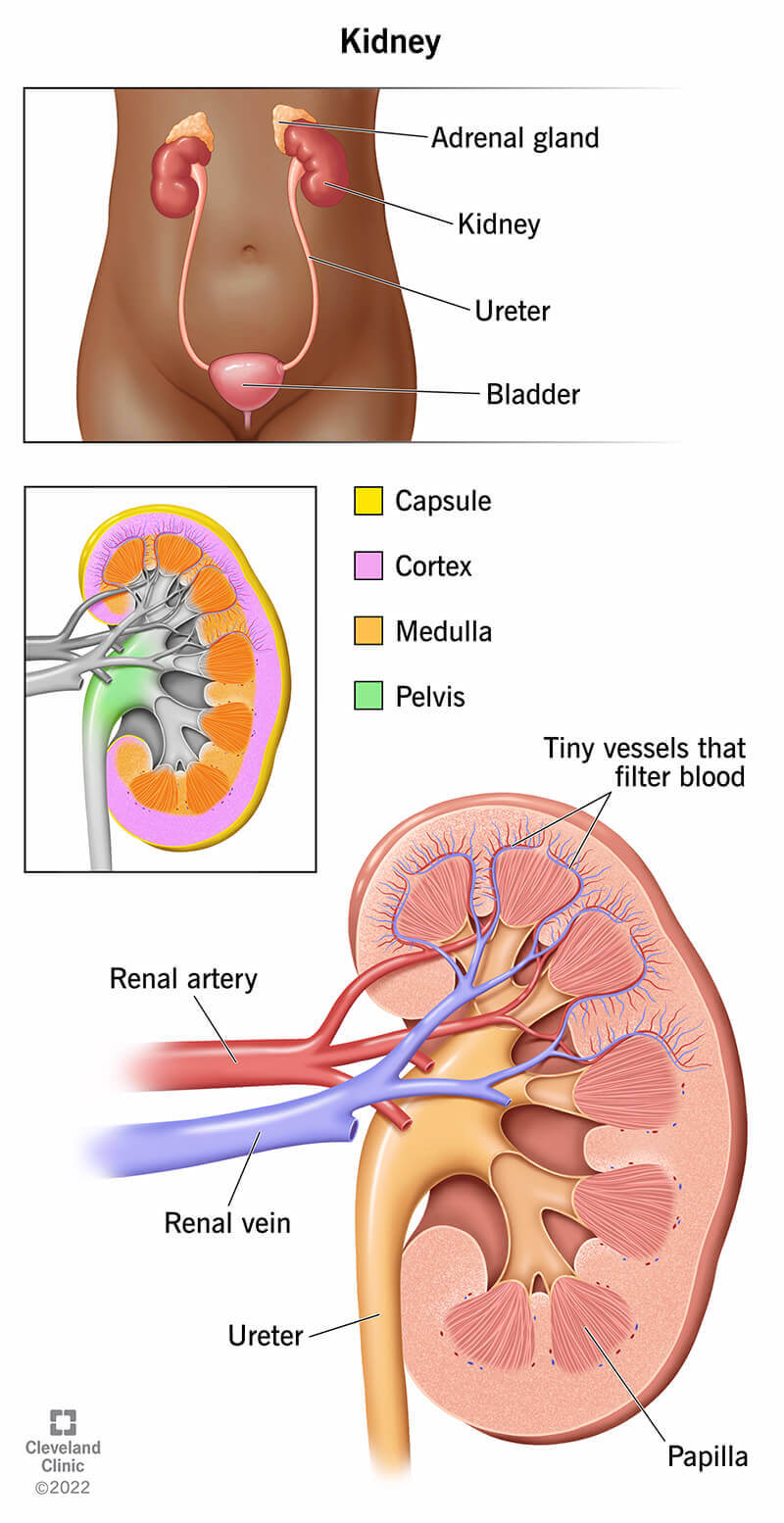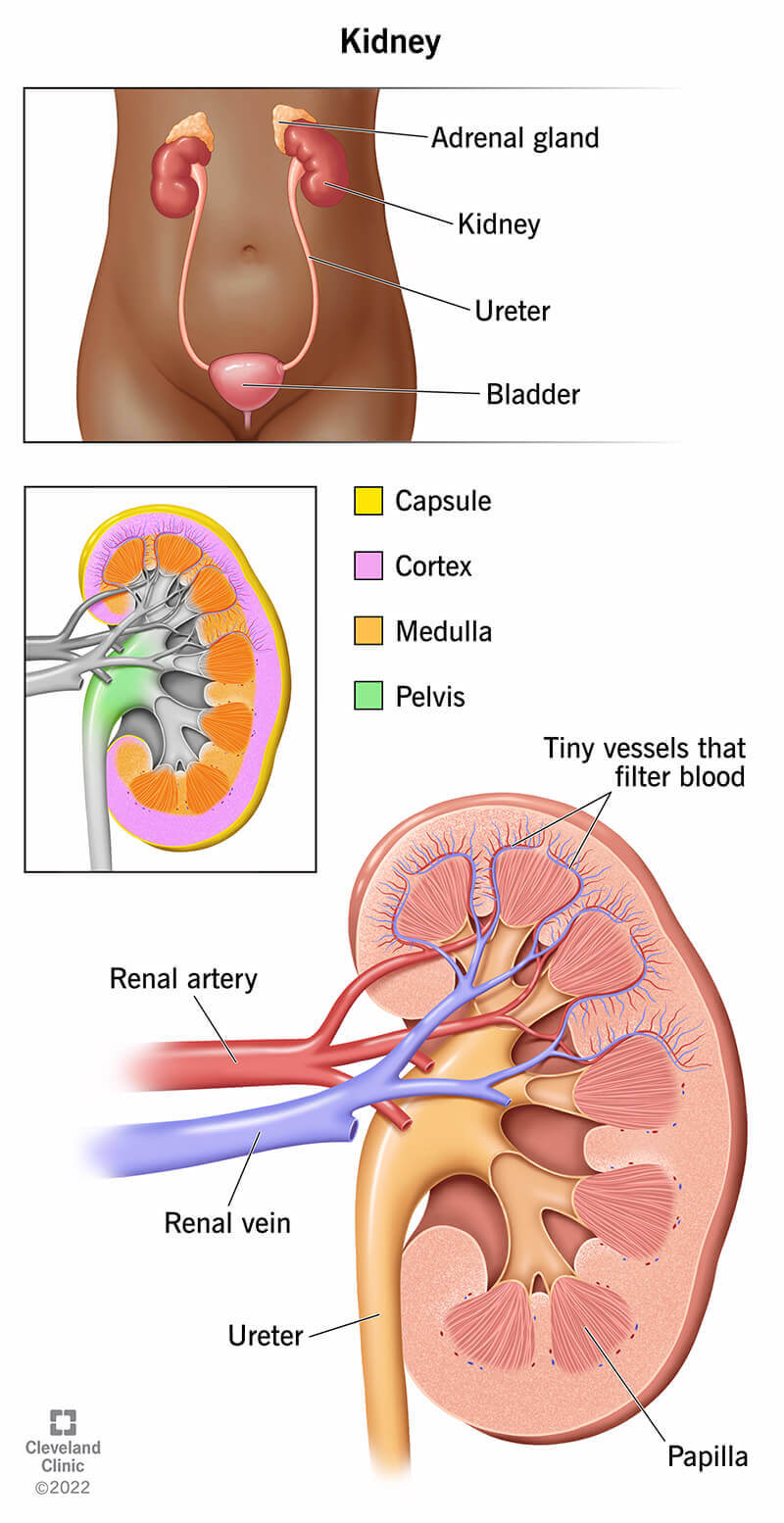Your kidneys are organs that filter your blood. They remove waste and balance your body’s fluids, among other tasks. Most people have one kidney on either side of their spines (in their lower back). Common kidney conditions include kidney disease, kidney infections and kidney cysts.
Advertisement
Cleveland Clinic is a non-profit academic medical center. Advertising on our site helps support our mission. We do not endorse non-Cleveland Clinic products or services. Policy

The kidneys are two fist-sized organs that filter your blood. Your kidneys are part of your urinary system.
Advertisement
Cleveland Clinic is a non-profit academic medical center. Advertising on our site helps support our mission. We do not endorse non-Cleveland Clinic products or services. Policy
Your kidneys filter about 200 quarts of fluid every day — enough to fill a large bathtub. During this process, your kidneys remove waste, which leaves your body as urine (pee). Most people pee about 2 quarts daily. Your body reuses the other 198 quarts of fluid.
Each kidney also helps balance your body’s fluids (mostly water) and electrolytes. Electrolytes are essential minerals that include sodium and potassium.
Your kidneys have many important functions. They clean toxins and waste out of your blood. Common waste products include nitrogen waste (urea), muscle waste (creatinine) and acids. They help your body remove these substances. Your kidneys filter about half a cup of blood every minute.
In the process:
The kidneys also:
Advertisement
Each kidney contains more than a million filtering units called nephrons. Each nephron consists of:

Your kidneys sit just below your rib cage and in your lower back. Typically, one kidney sits on either side of your spine. Your kidneys are between your intestines and diaphragm. A ureter connects each kidney to your bladder.
Your kidneys are highly complex organs with many parts. The main parts of your kidney anatomy include:
Your kidneys are reddish-brown. They have a shape like a kidney bean. Each kidney is about 4 or 5 inches long, about the size of a fist.
The weight of your kidneys varies. It depends on your height, weight, age and body mass index (BMI). Your kidneys may weigh as much as one to five tennis balls.
An adrenal gland sits on top of each kidney. It produces hormones, including cortisol, which helps your body respond to stress.
Common diseases that impact your kidneys include:
Advertisement
Countless other disorders can affect your kidneys. Some of these conditions include:
Advertisement
People with diabetes or high blood pressure have the highest risk of kidney problems. Accidents or trauma can also harm your kidneys, like car accidents or sports injuries.
Most kidney problems don’t have signs in their early stages. As kidney damage progresses, you may notice:
Healthcare providers use several tests to measure kidney function and diagnose kidney problems. Your provider may recommend:
Advertisement
It’s important to have regular checkups and blood and urine tests to measure your kidneys’ health. You can reduce your risk of developing a kidney problem by:
You should have your kidney function regularly tested if you have:
You can live with just one kidney. Healthcare providers may remove one of your kidneys in a radical nephrectomy.
Someone may have only one kidney if they:
When your kidneys are working well, you probably don’t think about them too much. Your kidneys are like a nonstop cleaning crew for your blood. They filter your blood and remove waste from your body. Your kidneys also help balance your body’s fluids and electrolytes.
Many different conditions may affect your kidneys, so it’s essential to take steps to keep your kidneys healthy. Regular testing is a good idea if you have a high risk of kidney problems.
When your child has kidney problems, you’ll want the best care. Cleveland Clinic’s experts in kidney care for children are here to help.

Last reviewed on 11/05/2025.
Learn more about the Health Library and our editorial process.